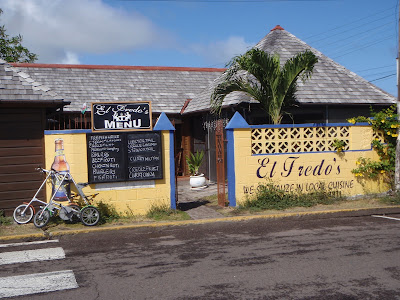Ft. Brimstone was constructed by African slave labor over a
period of almost 100 years back when the French and English were squabbling
over control of the Caribbean. It is
strategically situated on the northwest corner of St. Kitts and from there you
can see six islands including Saba, St. Martin and Montserrat.
The first cannon was hauled up the hill in 1690 by the
British with the intent of capturing the French built Ft. Charles on the shore
below.
After successfully recapturing Ft. Charles, the British
quarried the local volcanic rock, produced cement using limestone kilns, and
built walls that range from 6’ to 10’ thick.
By 1736, Ft. Brimstone had 49 cannons, many were the
24-pounders that were considered the most formidable weapon of their time.
The fort comprises 11 different areas sprawled over 40 acres
on three levels.
The lower placements sit 100’ to 300’ below the citadel on
the top.
The fortress looks
impenetrable, but it was taken by the French in 1782. Eight thousand French troops laid siege to
the fort that was defended by 1,000 soldiers from the Royal Scots. The battle
lasted 30 days and bought valuable time for Britain’s Admiral Hood and Admiral
Rodney to inflict heavy damage to the French fleet.
After the British surrendered, the French graciously allowed
the British to march out with full military honors.
The Treaty of
Versailles returned the fort to British control. Ft. Brimstone remained an active British
outpost until 1852 when it was abandoned.
The Society for the Preservation of Brimstone
Hill was founded in 1965 and turned
the overgrown ruins into a tourist attraction.
In 1973 H.R.H. Prince Charles re-opened the first restoration. While we were visiting, archaeologists were
busy digging near some ruins and were excited to find that the ruins were
formerly a latrine. They interrupted
their labor when Pollie showed an interest and attempted to recruit her. Should you be interested, contact Caribbean Volunteer Expedition at www.cvexp.org.

.jpg)






















+(800x536).jpg)
+(800x600).jpg)
+(800x536).jpg)
+(800x536).jpg)
+(800x536).jpg)
+(800x536).jpg)
+(800x536).jpg)

+(800x536).jpg)
+(800x600).jpg)
+(800x600).jpg)

+(800x536).jpg)
+(600x800).jpg)
+(800x536).jpg)